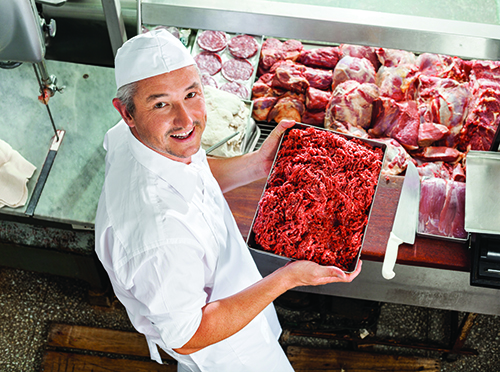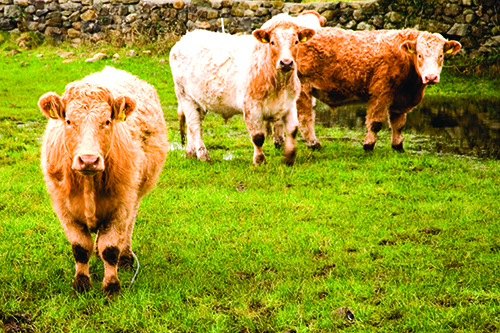Beef market in crisis?
 Irish beef prices are set to come under pressure in the second half of 2016.
Irish beef prices are set to come under pressure in the second half of 2016.
Approximately 120,000 additional cattle were born in Ireland last year. In tandem with this, a 60,000 drop in live cattle exports was recorded during the same period. It doesn’t take a genius to work out that significantly enhanced quantities of Irish beef will be hitting world markets from this autumn onwards. This is the backdrop against which the debate on future Irish beef prices is now taking place.
BordBia’s Joe Burke believes that there will be an extra 50,000-80,000 herd brought to slaughter later this year. Irish beef prices have been determined, almost exclusively, by a supply-based scenario over recent years. So the envisaged increase in cattle numbers later in 2016 may well put pressure on farm gate returns at that stage.
Irish Cattle and Sheep Farmers Association (ICSA) beef Chairman, Edmond Phelan believes that farmers need to realise that now is the time to drive up prices while cattle are still scarce.
“Cattle will be much scarcer for the first six months of 2016. Already there are signs of cow price hardening which is always a positive sign for finishers. This won’t happen however, while people continue to sell prime beef at €3.90/kg. Farmers need to get tough and fast, in the coming weeks when beef will be scarce.”
However, Mr Phelan said that the longer run picture suggests price weakness towards the end of 2016.
“We need the Government to concentrate on doing everything possible to facilitate live exports in 2016,” he said. “There is also an onus on farmers to re-evaluate what they are doing. Farmers who are keeping dairy calves at home instead of allowing them be exported to continental veal units need to look very carefully at the economics of what they are doing. Suckle farmers need to consider reducing cow numbers by at least 5 per cent.”
“In the bigger picture, the national strategy of expanding production is a disaster for farmers. Run faster to stand still. Farmers need to take a serious reality check about the economics of extra livestock whether on dairy or beef farms. It is clear that the beef sector here needs to contract rather than expand given that every time cattle numbers increase even slightly, price drops below the cost of production.”
 “The time has come to look at the way in which supports are designed with a view to giving farmers real options. Agri-environment supports should include better support for alternative crops on a portion of the national land base which might also benefit climate change targets while facilitating the continuation of efficient grass based systems if, and only if, production remains profitable.
“The time has come to look at the way in which supports are designed with a view to giving farmers real options. Agri-environment supports should include better support for alternative crops on a portion of the national land base which might also benefit climate change targets while facilitating the continuation of efficient grass based systems if, and only if, production remains profitable.
“Forestry supports need to be made more attractive and should apply over a much longer term as well. The bottom line is that to continue to produce as much beef as we do at a loss is insanity and it’s time for a national debate on this. Less can be more.”
Mr Phelan also expressed concern at the increase in Polish beef imports to the UK. “Farmers would not like to think that Irish beef factories could see this as a source of cheap cattle to drive down price for British or Irish farmers.”
But it’s not all bad news, as Teagasc economist Thia Hennessy believes that the Euro will remain weak against sterling and the US dollar for the foreseeable future.
“The prospect of interest rates rising in both the UK and the United Sates should help to keep the Euro relatively weak against both currencies,” she said. “This is good news for farming in Ireland as it will ensure that our food exports to both these markets remain extremely price competitive.
“The exchange rate factor has been crucial in boosting the euro value of Irish food commodities over recent months. And this has been reflected in farm gate prices.”
Meanwhile in Northern Ireland, deadweight cattle returns are much more exposed to fluctuations in the euro/sterling exchange rate. This is because a greater proportion of the province’s manufacturing beef and cheaper cuts are exported to European markets, than is the case in Britain.
The average euro/sterling exchange during December 2015 was €1 = 72p compared to €1 = 79p in the same period of 2014. According to the Livestock and Meat Commission (LMC), gaining access to important markets beyond the EU in Asia, Northern America and the Middle East will be a key priority for Northern Ireland’s meat exporters.
Significantly, the Commission plays a strategic role facilitating the opening of new markets through its membership of the UK Export Certification Partnership (UKECP). LMC is a co-founder of this joint industry/government programme, the aim of which is to establish access for UK red meat products into third country markets.
Meanwhile, Ulster Farmers Union beef and lamb policy chairman, Crosby Cleland, has said prices being paid for beef need to strengthen as farmers finishing cattle continue to suffer heavy losses.
“This time last year beef producers were receiving in the region of 360p/kg, which is as low as prices can be if livestock coming off a farm here are to break even. Unfortunately at the end of 2015 producers saw no improvement in the market in the run-up to Christmas, which has always been a feature of the beef trade.
“As a result prices fell well below the cost of production, leaving many finishers with losses that top £200/head.”
He added that Northern Ireland’s beef producers have had to live with sustained downward pressure on prices for a significant period of time.
“This is having a negative impact on the income of many local farms at a time of year when costs are high. Many farmers will also be adjusting to reduced payments within the new CAP system. Processors seek to blame weak demand for these poor prices. But the reality is those same businesses continue to pay upwards of 35p/kg more for cattle in Great Britain than here.
“There is no justifiable reason for this, especially when you consider that the difference was only 5p/kg this time last year.”
One good news story for Northern Ireland’s livestock sector in 2016 has been the opening up the Canadian beef market to imports from the province.
“The Canadian beef herd is recovering from a period of decline,” said UFU deputy president Ivor Ferguson. “Forecasts suggest its domestic beef supplies will be tight in 2016, so hopefully this will be an opportunity for exports. Our hope is that these will help tackle the poor prices farmers are currently facing.”





